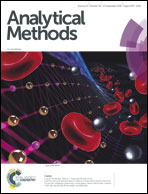A bionanocomposite-modified glassy carbon electrode for the determination of 4,4′-methylene diphenyl diamine†
Abstract
A nanosensor based on a glassy carbon electrode modified with the biopolymer chitosan, multi-wall carbon nanotubes, and gold nanoparticles (MWCNTs–CS–AuNPs/GCE) was developed for the determination of 4,4′-diaminodiphenyl diamine (MDA). Cyclic voltammetry (CV) was used to investigate the electrochemical behavior of the sensor in the presence of MDA. MDA displayed a well-expressed oxidation peak at 0.54 V (versus Ag/AgCl) in Britton–Robinson (B–R) universal buffer solution (pH = 10). The transfer coefficient, α, and the overall number of electrons (n) involved in the catalytic oxidation of MDA at the MWCNTs–CS–AuNPs/GCE surface were also determined by CV. The reactivity of spiked MDA was strongly dependent on the pH of the supporting electrolyte, with the pH dependence of the MDA oxidation quantified as 27.576 mV pH−1. Through chronoamperometry, the diffusion coefficient (D) of MDA was calculated to be 9.49 × 10−5 cm2 s−1. The limit of detection of MDA was estimated to be ∼20 nM through amperometry experiments, while three linear ranges were found for MDA, i.e., 0.49–10.14 μM, 10.14–94.9 μM, and 94.9–261.18 μM. Real sample tests enabled us to emphasize the potential of this nanocomposite-modified electrode as a new analytical tool for the determination of MDA.



 Please wait while we load your content...
Please wait while we load your content...